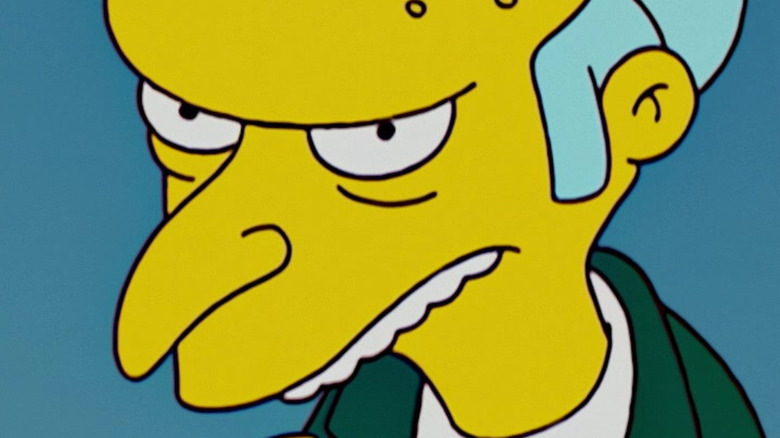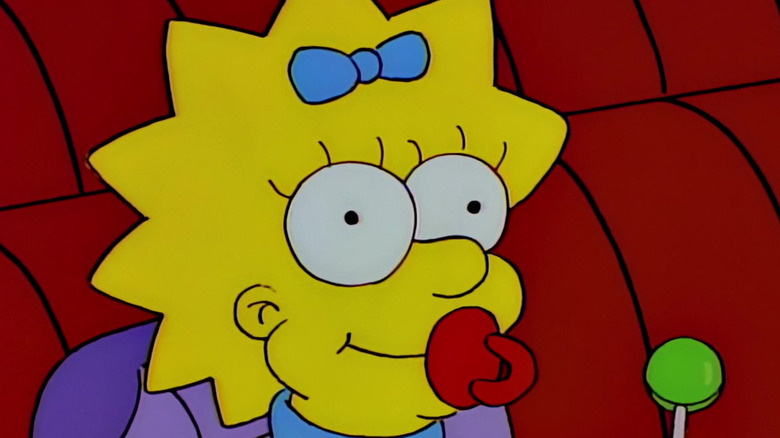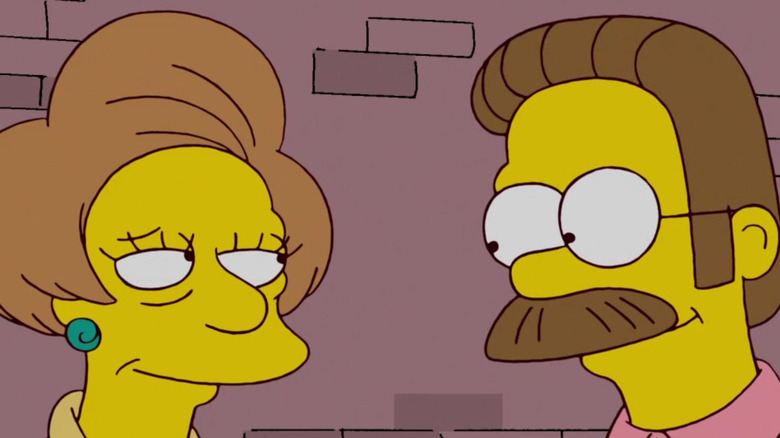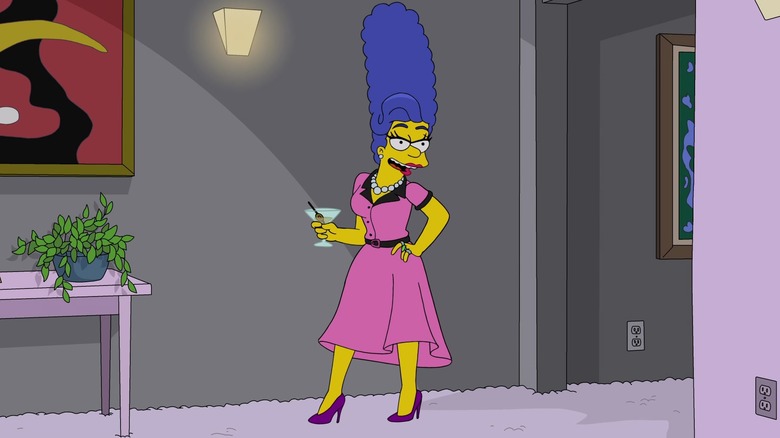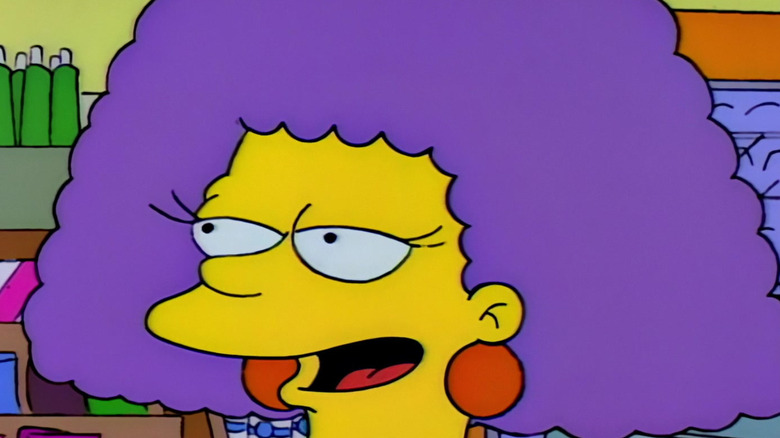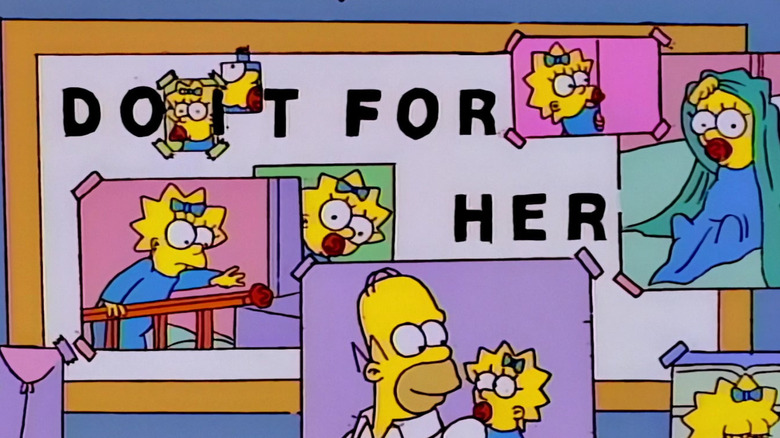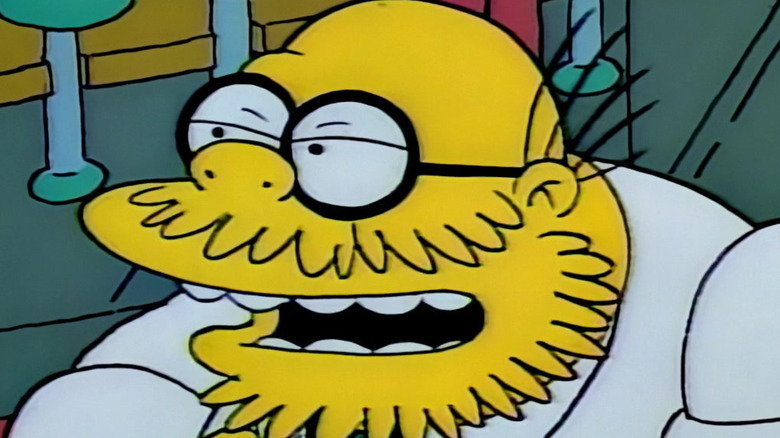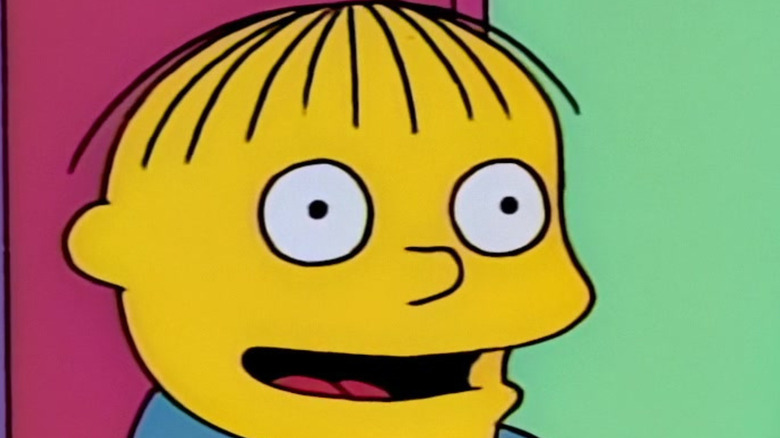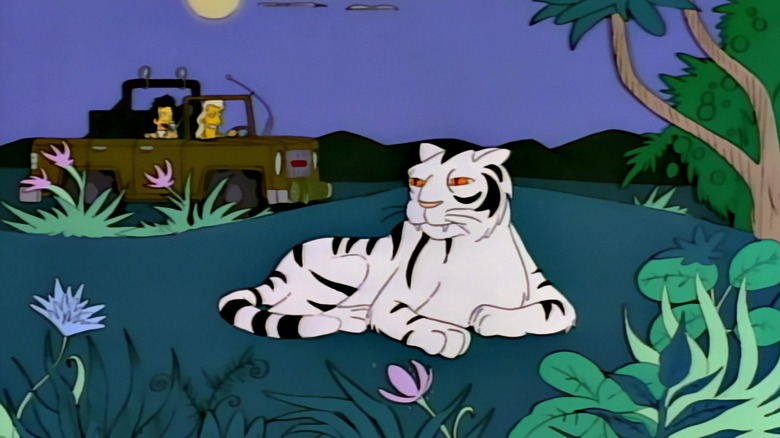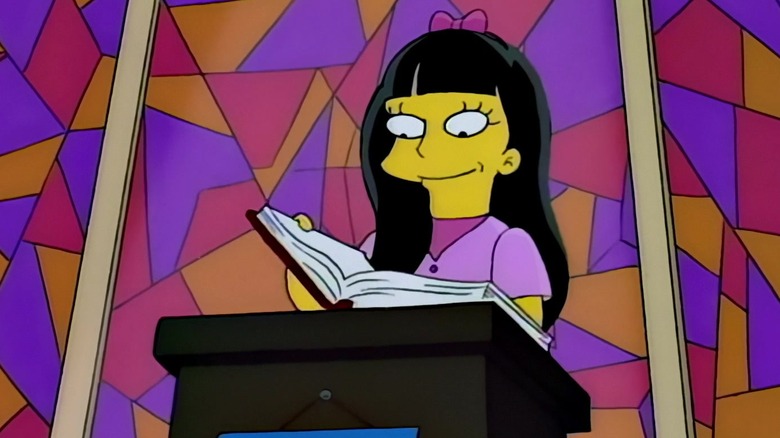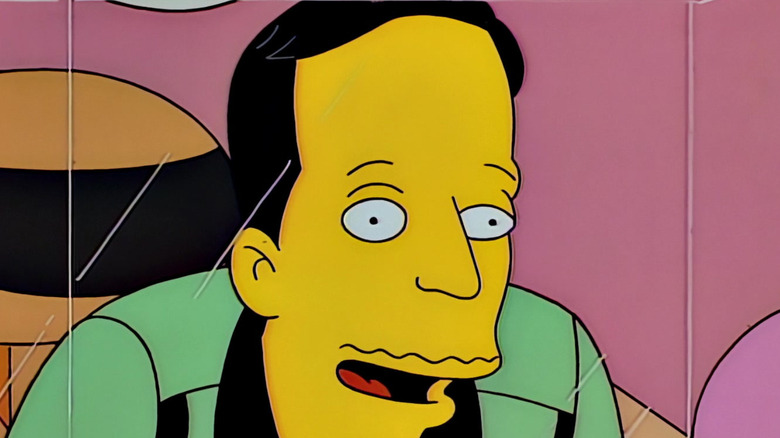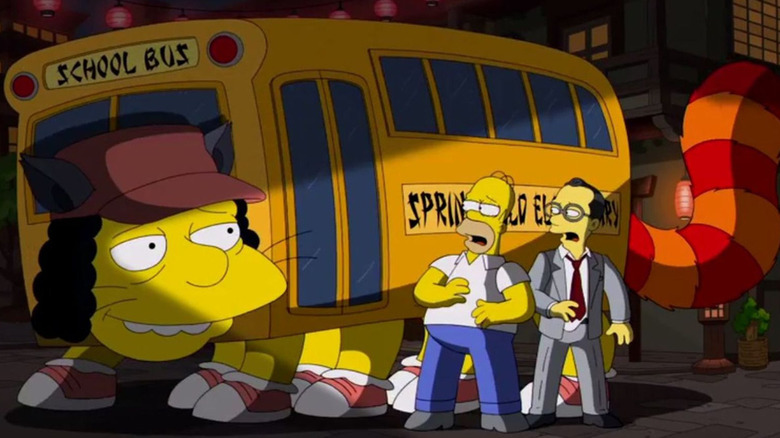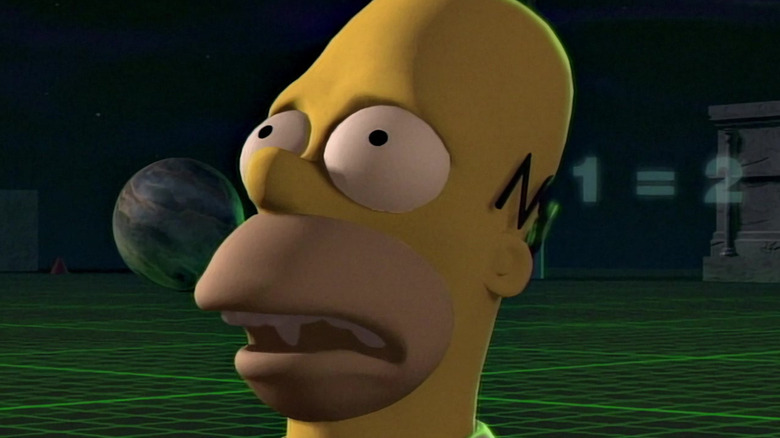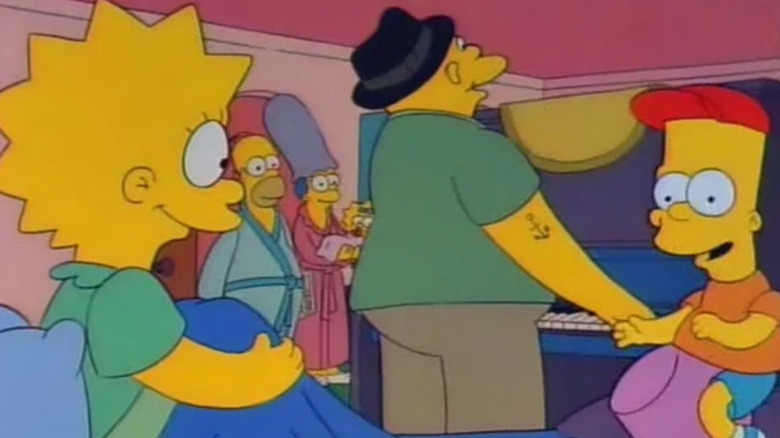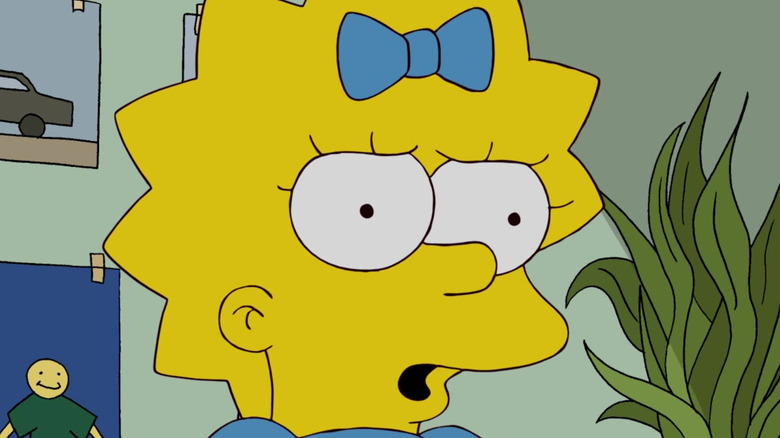The Most Pause-Worthy Moments In The Simpsons
"The Simpsons" has commanded our screens for more than 30 years. The titular family provides a vast array of lovable moments, even at their most dysfunctional. Endless side characters come and go over the course of the series' seasons, which makes the show an ever-changing portrait of American suburbia. As a result, "The Simpsons" has had more than its fair share of unexpected twists, shocking scandals, and iconic catchphrases.
You might think this avalanche of content would make it harder for "The Simpsons" to produce moments that stand the test of time. But while this yellow world of fun and foolishness is enormous and, in many ways, unchanging, it still hasn't run out of ideas. Every new season brings new thrills, surprises, and laughs which make fans reach for the remote, freeze the action, and exclaim, "Did I really just see that?" From dancing drag queens to nods to the third dimension, these are the most pause-worthy moments in "The Simpsons."
Maggie is revealed as Mr. Burns' shooter
"Who Shot Mr. Burns?" is a classic whodunit. This 1995 two-parter, which forms the last episode of Season 6 and the first episode of Season 7, begins with the discovery of oil under Springfield Elementary. Mr. Burns plots to steal it, which ends up getting him shot by an unseen assailant. Springfield residents become super-sleuths to figure out who pulled the trigger, but the case is tough to crack. It's no secret that Burns has made many enemies, with the likes of Sideshow Mel, Krusty the Clown, and even trusty aide Smithers taking the courtroom stand. But no one expects the truth: In one of her best-ever moments, Maggie Simpson shot Mr. Burns after he tried to take her lollipop.
Full of hidden clues and red herrings, these episodes remain fan favorites. In fact, Maggie's reveal is so shocking, it still prompts debate. Over the years, a number of conspiracy theories have emerged online, including one from Reddit user Game_of_Jobrones that claims Homer would have shot Burns if the infant hadn't beaten him to it. Is that true? It's up to you. But one thing is clear: Maggie's role in the perfect crime kept viewers in suspense all summer long.
Edna and Ned go on a date
"The Simpsons" is known for being unpredictable, but even so, nobody expected goody-two-shoes neighborino Ned Flanders to fall for down-and-out teacher Edna Krabappel. After a prolonged spell of loneliness following Maude Flanders' death, Ned makes his move on Edna in Season 22's "The Ned-Liest Catch." When Edna falls from a high ladder in an effort to escape a boring teacher reassignment room, Ned catches her. But the course of love isn't smooth: Ned is put through his paces by the indomitable teacher. But soon enough, he adjusts to the midday glasses of wine that make Edna unique.
By bringing together Ned's devout Christianity and Edna's saltier sensibilities, "The Simpsons" creates a lasting couple. But the moment Edna falls into his arms is still shocking, because, well, they really are very different. But the lovebirds soon win the audience over by bonding over their shared experiences with the Simpsons family. They get married in Season 23's "Ned 'N Edna's Blend Agenda." Their true — if unexpected — love never dies, with Ned taking up a teaching role to honor Edna after her death.
Marge becomes a drag queen
We've got one thing to say: Marge better werk. Desperately seeking a new job, Marge creates a drag queen persona to sell Tubberware in Season 30's "Werking Mom." Her mentor, Queen Chante — voiced by global drag icon RuPaul — soon helps Marge dazzle the Draggle Rock bar. Taking to the runway with a parody rendition of RuPaul's "Glamazon", Marge performs a show-stopping routine complete with death drops, rocket cannons, and an entire ironing sequence.
This scene is such far cry from the politically incorrect days of early "Simpsons" seasons, it makes fans reach for the pause button. Marge is able to embrace newfound confidence, thanks to the kindness of the drag community. "Werking Mom" is bursting with well-known "RuPaul's Drag Race" catchphrases and cameo appearances from queens such as Raja Gemini. Marge's performance is also one of the show's strongest musical numbers, full of sassy beats that spice up the typical "Simpsons" format. Be sure to keep an eye out for the familiar yet supposedly mysterious Waylon, a drag queen who bears a strong resemblance to a certain Springfield assistant.
Selma decides she wants a baby
After Marge, Patty, and Selma's great aunt dies in Season 4's "Selma's Choice," they discover she's left the twins a warning not to end up unmarried and childless like her. While Patty is happy with her life, Selma finds her pet iguana Jub-Jub is no longer satisfying in the wake of this loss. She makes a momentous decision that shocks the Simpsons family: She wants to have a child.
Selma's lightbulb moment starts a fascinating conversation about motherhood, single women, and the oft-avoided topic of artificial insemination. "Selma's Choice" was undoubtedly groundbreaking for 1993, and remains a far cry from the slapstick, silly humor the show is known for. Sadly, after taking Bart and Lisa to Duff Gardens and losing them to petty crime and water poisoning, Selma questions her parenting skillset. That's pretty rich when you consider her brother-in-law is Homer. But at least viewers get to see more of Selma's relationships and child-related mishaps in future seasons, from dating murderous Sideshow Bob to a sham marriage with wannabe actor Troy McClure to finally adopting her daughter, Ling.
Homer finally feels some fatherly love
Whether you regularly watch "The Simpsons" or not, Homer's lack of paternal responsibility is legendary. From strangling Bart to using Lisa's football smarts for gambling, he's never been the ideal father figure. When it comes to Maggie, his youngest child, there's hardly a relationship there at all. This is why fans were shocked by Season 6's "And Maggie Makes Three," which contains one of the most heartwarming Homer moments in the series.
In this episode, we flash back to 1993. Homer has his dream job in a bowling alley, but he has to quit when Marge reveals she's pregnant. Returning to his miserable job at the power plant, Homer is confronted with a vindictive plaque that promises he'll be there for life. Homer uses photos of baby Maggie to cover certain letters, resulting in a sign that reads "Do it for her".
In this, one of Homer's most genuinely touching moments, he proves he's come a long way from forgetting he had kids at all. It also spotlights how Maggie comes to love her all-important pacifier. No wonder it's widely regarded as one of the sweetest scenes in "Simpsons" history — and one of a number to become immortalized as a meme.
Is that Dr. Marvin Monroe?
Before Dr. Nick Riviera steals the show as the chaotic alternative to beloved Dr. Julius Hibbert, "The Simpsons" features a local counselor. First seen in Season 1's "There's No Disgrace Like Home," Dr. Marvin Monroe quickly becomes instrumental in saving the family's fraught relationships. With his gravelly voice and electroshock therapy, Monroe is one of Springfield's more interesting characters — until he disappears. Quietly phased out and killed off-screen during Season 7, explanations of what happened to him are thin on the ground.
However, in Season 15's "Diatribe of a Mad Housewife," Monroe appears alive and well at a book signing Marge is hosting. When she expresses surprise, he claims to have been ill. This move goes against all prior knowledge. This includes in-world knowledge: Homer is taken to the Marvin Monroe Memorial Hospital in Season 7's "Who Shot Mr. Burns? Part Two." They don't tend to name those after the living. Sometimes, he show's writers just have to throw continuity out the window and stir up chaos for a character with little backstory.
Ralph Wiggums' changing voice
Beloved for gems such as "I'm learnding!" and "Super Nintendo Chalmers," Ralph Wiggum is the clueless kid you just can't help but love. As one of Lisa Simpson's classmates, Ralph props up the other end of the academic scale. He's also one of Springfield's most prominent residents, appearing in every single season of the long-running series. Despite this fact — and his distinctive personality — Ralph's major traits can be mixed up. Fans learn this the hard way in Season 3's "Lisa's Pony."
In one scene of this episode, Ralph watches Lisa ride Princess, a pony Homer bought her after losing face. When Ralph speaks to a nearby child, he has the voice of school bully Nelson Muntz. It's the sort of moment that makes fans reach for their pause and rewind buttons, it's so bizarre. Ralph's daffy behavior and high-pitched voice have already been established by this point, making the switch a likely mistake. As this episode appears in the show's early days, this is understandable — but it's also possible that the creators were still experimenting with how their characters sound. Thankfully, they never chose to give Ralph such a gruff and straightforward voice again.
The Gunter and Ernst tiger attack
Over the years, "The Simpsons" has made itself known for its uncanny ability to predict the future. Whether it's the rise of Lady Gaga or video chatting, the show's creative team knows how to keep a finger on the pulse. One particularly shocking example of this occurs in the Season 5 episode "$pringfield (Or, How I Learned To Stop Worrying And Love Legalized Gambling)." In this installment, gambling is legalized in Springfield, leading Mr. Burns to build a gigantic casino. The palatial place hosts entertainment duo Gunter and Ernst, who perform their long-running magic show, complete with a white tiger on a unicycle. A few moments later, the tiger attacks the pair and rips them to pieces.
This scene, which premiered in 1993, came horrifically true 10 years later. In 2003, Roy Horn, one half of the legendary performance duo Siegfried and Roy, was mauled on stage by a white tiger, according to the BBC. Thankfully, Horn survived, but this awful incident undoubtedly continued the bizarre "Simpsons" streak of predicting the future. While this scene was initially just a brutally funny joke, it makes modern fans hit pause to reflect on the blurred line between fiction and reality.
Jessica Lovejoy's familiar voice
When Bart isn't causing chaos on the streets of Springfield, he's doing it at school or 742 Evergreen Terrace. It's surprising, then, that he manages to find time for a steady girlfriend, but that's exactly what happens in Season 6's "Bart's Girlfriend." What's even more surprising is said girlfriend's voice actor. When Jessica Lovejoy, Reverend Lovejoy's daughter, returns to Springfield after being expelled from boarding school, a smitten Bart cleans up his act in order to catch her eye. Little does he know it's the bad boys she's interested in. Soon enough, Jessica gets him into even more trouble than he's used to. With her chic pink dress, doe eyes, and sweet voice, Jessica is a devil in disguise ... voiced by none other than Meryl Streep.
Whether she's throwing toilet paper over Jebediah Springfield or racing down hills on a skateboard, Jessica's voice is familiar, but hard to quickly place. Before the days of Googling and IMDb, hardcore fans had to rewatch these scenes over and over again to figure out how they knew Jessica's voice — or simply fast-forward to the credits, if they were impatient. Though this episode first aired in 1994, Streep already had two Academy Awards under her belt thanks to "Kramer vs. Kramer" and "Sophie's Choice." People undoubtedly recognized her dulcet tones, even if they weren't quite sure exactly who they were hearing. She still stands out as one of the best actors to ever guest star on "The Simpsons."
Homer and Bart meet John Waters
Being gay on television hasn't always been an option for performers, characters, or creators. But major strides were made in the 1990s, including the time John Waters guest-starred on "The Simpsons." In the Season 8 episode "Homer's Phobia," which debuted in 1997, Homer and Bart meet John, the openly gay owner of a local memorabilia shop. With his iconic "zap!" catchphrase and plenty of goofy collectibles, John started a cultural conversation that went far beyond Springfield's boundaries.
The Simpsons clan quickly takes to John, but Homer is thrown when he learns John is gay. As he desperately tries to ensure Bart's heterosexuality, he is forced to confront his prejudices head-on. Homer doesn't become the most tolerant person around, but he does ultimately accept John for who he is. Moreover, John isn't the butt of the episode's joke — that role falls to foolish Homer. None of this might seem shocking to modern viewers, but in 1997, it was groundbreaking stuff. And it all begins with the pause-worthy moment John is revealed to be gay.
The Simpsons meet Studio Ghibli
While "The Simpsons" is one of animation's most famous creations, even it is dwarfed by the work of Studio Ghibli. The legendary Japanese animation studio is a household name across the world, thanks to films like "Spirited Away," "Ponyo," and "Howl's Moving Castle." While the dysfunctional family at the heart of "The Simpsons" gets up to all sorts of carefree silliness, Studio Ghibli's stories blend beautiful artistry with lasting life lessons. The idea of these very different works of animation coming together is jarring — but it's also a reality.
In Season 25's "Married To The Blob," Comic Book Guy falls for Kumiko, a Japanese manga artist. She likes him too, but her father, Mr. Nakamura, objects to their relationship after Homer reveals Comic Book Nerd's dweeby personality. In an attempt to patch things up, Homer and Mr. Nakamura go out for drinks, and end up venturing into the anime side of town.
Here, we find Otto the Catbus, Patty and Selma's delivery service, and Apu's moving Kwik-e-Mart. A mixture of Agnes Skinner and Yubaba is a particular treat for the eyes. All in all, it's a touching tribute to one of the finest animation houses in history. Plus, as in every Studio Ghibli film, Homer and Mr. Nakamura learn a valuable lesson along the way: Kumiko must be free to love whoever she wants.
Treehouse of Horror in 3D
No matter how many "Simpsons" seasons come and go, the "Treehouse of Horror" Halloween episodes can always be trusted to deliver the goods. Typically loaded with three short stories, these installments have a continuity-free license to go wherever they want, from torture by doughnuts to a recreation of "The Shining." In Season 7's "Treehouse Of Horror VI," the Simpsons find a portal to an alternate reality hidden behind their bookcase. Enticed to the other side by not having to see Patty and Selma, Homer enters a three-dimensional plane where he is literally fleshed out. This was the first time 3D animation had been used on the show, and in 1995, it was pretty mind-blowing.
Homer soon realizes he's trapped in this strange new dimension. Its design is indicative of its era: He wanders a very simple landscape made of geometric green lines, where stray math equations float in the sky. Fans who have played 2003's "The Simpsons: Hit & Run" video game will find this aesthetic somewhat familiar. But 1995's slow-moving Homer doesn't really know what he's doing: Rather than joyride cars or kick bins over for coins, he wanders around aimlessly until he accidentally punctures the landscape with a free-floating cone. This sends him to an even weirder world: The live-action streets of our own Los Angeles. Homer's trip to the third dimension is brief, but hugely memorable.
Happy birthday, Lisa
Michael Jackson appears in Season 3's "Stark Raving Dad," but not as you might expect. When Homer is committed to a mental institution, he meets a tall white man who claims to be Michael Jackson. He manages to convince clueless Homer, who brings him home to meet the family. Ultimately, "Michael" admits he's not the famous pop star — he's just a bricklayer named Leon. But here's the twist: This character is, in fact, voiced by Michael Jackson.
This isn't the episode's pause-worthy scene, however. That moment arrives when Leon helps Bart celebrate Lisa's overlooked birthday. Bart and Lisa haven't fought much at this point in the series. The fact that they do here, when Bart forgets what day it is, is a major turning point in their relationship. After realizing his mistake, Bart gets Leon to help him perform "Happy Birthday, Lisa," a sweet song bursting with brotherly love. This catchy tune is one of the best musical moments in "Simpsons" history, and it helps unite the whole family as they kick off a new season.
Maggie finally speaks
The Simpsons family doesn't really age, which means Maggie, who's too little to talk, is left with the short end of the stick. Fans waited patiently to find out what she sounds like, and finally, in Season 4's "Lisa's First Word," they were rewarded: Maggie utters her first word, "Daddy." But it wasn't until 2009 that viewers got to hear her say something a little bit lengthier.
Season 20's"Four Great Women and a Manicure" tells four stories about four women: Snow White, Lady Macbeth, Queen Elizabeth I, and Ayn Rand. Maggie, of all people, portrays Howard Roark, hero of Rand's book, "The Fountainhead." Getting her fellow babies to rebel against the enforced conformity of their daycare center, Maggie delivers an empowering speech promoting the artist's right to unadulterated freedom. What's even more interesting is the fact that her voice is provided by Jodie Foster. Although it's not the focal point of the episode, this scene is monumental in its own right, given Maggie's sudden wordiness. After this burst of talkative energy, she quickly reverts back to silent nap time. It may only be a glimpse of who Maggie might become, but it offers her the opportunity to finally have her voice heard.
